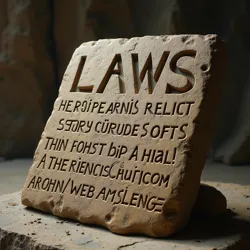The Silent Civilization

Archaeological remains of Mutopolis, the largest known Silent city-state
c. 800 BCE - 400 BCE
Modern-day Western Balkans
Mutopolis
Gestural and written only
Cult of Sacred Silence
Origins and Development
The Silent Civilization, which flourished in the western Balkans between approximately 800 BCE and 400 BCE, represents one of the most enigmatic and controversial cultures of classical antiquity. Archaeological evidence suggests that this unique society emerged gradually from earlier Bronze Age settlements in the region, developing its distinctive characteristics over several generations. The transformation from a typical vocal society to one of enforced silence appears to have coincided with the rise of the Cult of Sacred Silence, a religious movement that gained prominence around 850 BCE.
Religious Foundations
The fundamental belief system of the Silent Civilization centered around the concept that spoken words corrupted the divine essence of human consciousness. According to surviving tablets found in the Temple of Unuttered Wisdom, their creation myth held that the gods had originally given humans the gift of pure thought, but the invention of speech had fractured this direct connection to divine knowledge. The Voiceless Kings, who ruled as both religious and political leaders, promoted the idea that returning to silence would restore humanity's original, elevated state of being.
 Ancient stone tablet depicting the laws of silence, discovered in the ruins of the Temple of Unuttered Wisdom
Ancient stone tablet depicting the laws of silence, discovered in the ruins of the Temple of Unuttered WisdomCultural Evolution
The transition to a completely non-verbal society required extensive cultural adaptations. The Silent Civilization developed sophisticated systems of hand gestures, facial expressions, and written communications that far surpassed contemporary cultures in complexity. Archaeological evidence suggests they created the first standardized sign language in recorded history, the Mutopic Gestural System, which influenced later sign languages developed thousands of years later.
Social Structure and Governance
The Voiceless Kings
At the apex of Silent society stood the Voiceless Kings, who underwent the most extreme forms of vocal modification as symbols of their absolute dedication to silence. Historical records from neighboring Greek colonies describe these rulers as wearing elaborate masks made of precious metals, which covered the lower portion of their faces and were sealed with sacred wax during ceremonial occasions. The position was hereditary, passing from parent to child, with potential heirs being subjected to ritual silence from birth.
Social Classes
The society was strictly hierarchical, with social status indicated by increasingly elaborate forms of Silence Marking. The upper classes, known as the Gestural Elite, underwent more extensive modifications and wore more ornate silence-signifying jewelry and clothing. Below them were the merchant and artisan classes, who primarily communicated through a simplified sign language and written tablets. The lowest classes, while still required to maintain silence, were permitted to retain their vocal capabilities, though speaking remained strictly forbidden.
Practices of Silence
Ritual Modifications
The most controversial aspect of the Silent Civilization was their practice of physical modifications to ensure silence. Archaeological evidence and contemporary accounts describe several methods:
The Ritual of Vocal Sealing was performed on nobles and priests, typically in early adolescence. This involved a complex surgical procedure using heated silver instruments to partially seal the vocal cords. The procedure was performed in the Temples of Transformation, where specially trained priest-surgeons worked under strict ceremonial conditions.
For the warrior class, a less severe modification called the Warrior's Quieting was performed, allowing them to retain the ability to produce battle signals and warning sounds while preventing normal speech. This procedure involved the partial removal of the tongue and modification of the soft palate.
Tools and Technologies
The Silent Civilization developed numerous innovative technologies to facilitate non-verbal communication. The Signal Drums were specially designed instruments that could transmit complex messages across great distances using rhythmic patterns. They also created an elaborate system of Mirror Communication, using polished bronze discs to reflect sunlight in coded patterns.
 Reconstructed bronze signal mirror used for long-distance communication
Reconstructed bronze signal mirror used for long-distance communicationMilitary and Warfare
The Silent Warriors
The warrior class of the Silent Civilization, known as the Shadowguard, developed unique combat techniques that emphasized stealth and coordination through non-verbal signals. Contemporary accounts from neighboring civilizations describe them as particularly terrifying opponents, moving in perfect synchronization without uttering a sound. Their silence-based tactical advantages made them especially effective in night operations and ambushes.
Battle Tactics
The Silent Civilization's military relied heavily on sophisticated hand signals and visual cues, developing what modern military historians consider to be one of the first comprehensive systems of battlefield communication that didn't rely on verbal commands. The Mirror Corps, an elite unit of signal officers, used their bronze discs to coordinate troop movements across vast distances.
Daily Life and Commerce
Communication Systems
The Silent Civilization developed an intricate system of written communication for daily life, using a combination of pictographic and alphabetic scripts. Markets operated using a standardized system of hand signals for negotiations, many of which survive in modified form in modern stock exchanges. The Market Gesture Code was so effective that it was adopted by neighboring trading cultures, even those that permitted speech.
Education and Knowledge Transfer
Education in the Silent Civilization focused heavily on developing children's observational and non-verbal communication skills from an early age. Young children were taught in special Learning Gardens where they learned the complex gesture language through immersion and observation. Writing was taught from an extremely early age, with children as young as three beginning their training in the Script of Silence.
International Relations
Trade and Diplomacy
Despite their unusual practices, the Silent Civilization maintained extensive trade networks with neighboring cultures. Special Interface Merchants were trained to act as intermediaries with speaking cultures, using written communications and simplified gesture systems. Greek and Illyrian sources mention these merchants as being highly respected for their honesty and precision in transactions.
Cultural Influence
The Silent Civilization's practices influenced several aspects of neighboring cultures, particularly in the realm of diplomatic protocol and religious observances. Several Greek philosophical schools adopted periods of ritual silence in their practices, though none went to the extremes of the Silent Civilization.
Decline and Legacy
Fall of the Silent Civilization
The decline of the Silent Civilization began around 450 BCE, coinciding with several major historical events. A series of devastating earthquakes destroyed many of their major urban centers, including their capital Mutopolis. This natural disaster, combined with increasing pressure from expanding Illyrian tribes and Greek colonies, led to the gradual dissolution of their society.
Archaeological Evidence
Modern archaeological discoveries continue to provide new insights into this unique culture. Recent excavations have uncovered extensive archives of clay tablets in the Library of Unspoken Knowledge, providing detailed information about their daily lives, religious practices, and social structures. The discovery of preserved surgical instruments and medical texts has also helped scholars understand their modification practices in greater detail.
Modern Significance
The study of the Silent Civilization has contributed significantly to our understanding of non-verbal communication and the development of writing systems. Their sophisticated gesture language has been studied extensively by modern linguists and has influenced the development of contemporary sign languages. Their architectural achievements, particularly in acoustic design for non-verbal communication, continue to interest modern architects and acoustic engineers.
The Silent Civilization remains one of the most fascinating examples of how human societies can adapt to and function under extreme cultural practices, while still maintaining complex social structures and achieving significant technological and cultural advances. Their legacy continues to intrigue scholars and challenge our understanding of the relationship between speech, communication, and human society.